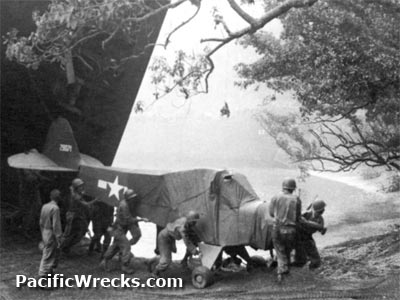|
|
|
|
| Missing In Action (MIA) | Prisoners Of War (POW) | Unexploded Ordnance (UXO) |
| Chronology | Locations | Aircraft | Ships | Submit Info | How You Can Help | Donate |
|
 U.S. Army January 2, 1944  US Army January 2, 1944 |
Location Sawoi village is located on Sawoi Point on the north coast of New Guinea. Pronounced "Sa-Woi". Allied wartime spelling Saui. To the south is Saui Beaches. Borders the Vitiaz Strait to the north and Dekays Bay to the east. Inland to the southwest is Saidor and Saidor Airfield. The Japanese referred to the Saidor area as Gumbi or Gumbo for Gumbi to the west. To the southeast roughly 110 miles beyond is Finschafen. Roughly 8-9 miles to the northwest is Biliau (Beliau). Prewar and during the Pacific War part of the Madang District in the Territory of New Guinea. Today, located in the Rai Coast District, Madang Province in Papua New Guinea (PNG). Wartime History During 1943, the Saui Beaches were used by the Japanese as a staging area for barge traffic transiting the north coast of New Guinea. On January 2, 1944 at dawn, a U.S. Task Force "Operation Michaelmas" enters Dekays Bay. Nine destroyers USS Beale (DD-471), USS Mahan (DD-364), USS Drayton (DD-366), USS Lamson (DD-367), USS Flusser, USS Reid (DD-369), USS Smith (DD-378) and USS Hutchins (DD-476) commence a preinvasion shore bombardment firing 1,725 5" shells at the landing area and targets. Next LCI(R) fire 624 4.5" rockets at the landing beaches and points inland from Sawoi (Saui). Bad weather prevents preparatory air strikes but over 80 B-24s, B-25s and A-20 bomb Saidor Airfield and areas inland from the landing beaches. At 7:25am the first wave of LCVP landing craft land after a slight delay due to bad weather land at Saui Beaches designated Red Beach, White Beach and Blue Beach. Over seventeen minutes, four waves of landing craft land 1,440 soldiers. Sixteen LCI land another 3,000 soldiers. There was no opposition aside from a few rifle shots as the U.S. Army, 6th Army, 32nd Infantry Division, 126th Regimental Combat Team (126th RCT) under the command of General Martin with the 120th Field Artillery plus other elements. Ashore, the Americans estimated only 15 Japanese were defending the beach and 11 were killed in the bombardment. Later in the afternoon, Japanese planes bombed the beachhead ineffectively but did result n one killed and several wounded plus two sailors drown at Blue Beach. By the end of the day, 6,779 personnel were ashore including 6,602 Army ground troops, 129 from Army Air Forces units, and 48 sailors. Afterwards, the Saui Beaches were developed into an staging area to support operations at Saidor. The area was developed with a LST landing areas on Saui Beaches with a fuel jetty and further to the south a lighter wharf and beyond a Liberty Ship wharf. References U.S. Army in World War II - Cartwheel: The Reduction of Rabaul Chapter XIV Crossing the Straits pages 273, 295-305 The 32D Infantry Division in World War II The ‘Red Arrow’ The New Guinea Campaign - Saidor Contribute
Information Last Updated
|
Map January 2, 1944 Map 1944 Map Mapcarta Photo Archive |
| Discussion Forum | Daily Updates | Reviews | Museums | Interviews & Oral Histories |
|